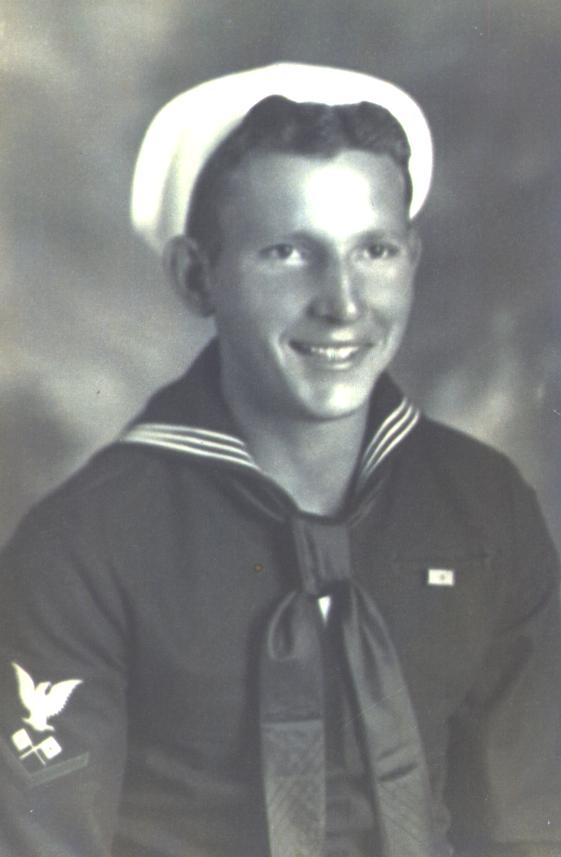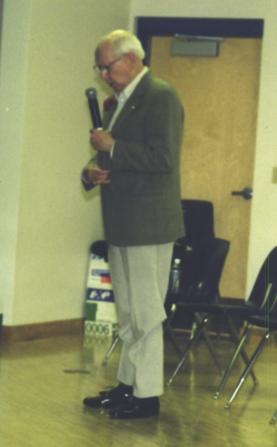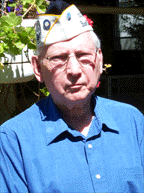B. E. "Gene" Merrill US Navy USS West Virginia |
I was a signalman on the USS West Virginia (BB 48). I had been relieved from the 4 to 8 watch on the signal bridge and was preparing to go on liberty. My living quarters were second deck forward. The shower I used was located on the main deck, right in the bow. To take a shower, I would strip, tie a towel around my waist, slip into my shower thongs, take a bar of soap and a wash rag and go up a ladder from my compartment to the main deck. I would then go forward, through about three compartments to the shower room. There were about eight or ten others in the shower room. I had finished my shower and was drying myself when the first torpedo struck the ship. There was a muffled explosion. The ship shuddered. The bow seemed to rise a few [feet and settle down. Someone said ''what the hell was that ?" Someone else replied that it was probably an explosion in an engine room. I tied the towel around my waist, and proceeded aft toward my quarters. I hadn't gone but a few steps when the second torpedo struck. Almost immediately, the PA system sounded GENERAL QUARTERS, with a comment from the boatswains mate of the watch, "The God dammed Japs are attacking." I headed for my battle station, losing the towel, thongs, soap and wash rag. My battle station did not involve guns. It was a signal station designed to hoist flag signals to the main yardarms in the event the signal bridge was blown away in a sea battle. Obviously my battle station was useless in a battle of this nature, so I volunteered to join a ten hand rescue party to go below and rescue those wounded by torpedoes. I have no idea how many we rescued. With no instructions, each of us used our own discretion. My modus operandi was to quickly examine a body for signs of life. If none was apparent, I moved on to the next one. However, questionable cases I rescued. I stayed below until the flooding salt water and oil forced me to evacuate. When I emerged to the topside, the batt1e was over. The ship sitting on the bottom with a port list, and burning. I left the ship with what I estimate to be the last twenty or twenty five men able to leave. *** MILITARY BlOGRAPHY B. E. "GENE" MERRILL, born Jan. 25, 1920 in Asheville, N. C. After a hitch in the Army, enlisted in the Navy Aug. 7, 1940. Was a signalman aboard the USS West Virginia until Dec. 7, 1941. After the sinking of the West Virginia, served on destroyers Mahan, DD 364, whipple, DD 217 and C. K. Bronson, DD 668. Also served aboard LST 1126 during the Korean war. Participated in many battles and operations, including the Battle of Midway, the invasions of The Marshall-Gilbert Islands,Hollandia, New Guinea, The Mariana Islands, The Philippine Islands, and numerous raids against Japanese positions, through the Battle of Cape Engano. When the war ended, was teaching Navy Communications Procedure in San Diego. Was discharged from the regular navy Aug. 7, 1946 as Chief Signalman, and immediately joined the Inactive Naval Reserve. Was called back to duty, for two years, during the Korean War. Spent a total of twenty four years of both active and inactive duty. Graduated from law school in 1957. Was Claims and Litigation Manager for a casualty insurance company. Retired, after a total of twenty eight years in insurance claims and litigation. After retirement from the insurance industry, became an Insurance Litigation Consultant, finally retiring after thirteen years. |
Information provided by Gene Merrill |



Mr. Merrill relates his experiences to the students at O'Callahan Middle School on November 13, 2001. |

WWII EXPERIENCES ABOARD THE USS MAHAN DD-364 As related by Gene Merrill I had survived the sinking of the battleship West Virginia on December 7th, and went aboard the Mahan in Pearl Harbor, December 13, 1941, as a signalman. During most of the first year of World War II, I saw many occurrences which became a permanent part of my memory several which I consider humorous, but they had to be humiliating to the parties involved. One day at sea, somewhere in the South Pacific, Executive Officer, Lt. W. J. Richter and Chief Quartermaster Anderson were on the signal bridge with a sextant taking a sun fix for the purpose of checking the ship's latitude. Hawkins, a fire-control-man, was on the director platform, eight feet above the signal bridge. Hawkins had just eaten lunch, and arrived to relieve the 8 to 12 watch. The sea was rather calm, but for some reason Hawkins became ill. He slumped over the railing of the director platform and retched. It fell on the head of the ship's executive officer, who was standing on the bridge below. Mr. Richter, our XO, was a rather low keyed person. Instead of exploding with anger, he took off his cap, looked at the mass of partially masticated food, looked up to Hawkins' ghostly white face, and said, "Hawkins why don't you chew your food better?" A somewhat similar incident occurred while in port one day. A signalman named Stapleton was swinging over the starboard wing of the signal bridge on a boatswain's chair. He was at work with a paint pot and brush. As if it had been rehearsed, the line holding the paint pot broke. The one-gallon pot, about half full, landed upside-down on Captain Simpson's head as he emerged from a doorway, below. His khaki uniform was suddenly battleship gray. Never at a loss for words, the captain spoke a few choice words, which I'm certain he didn't learn in Sunday school. Several officers and crewmen rushed to his aid, but he refused any assistance until after he was photographed for posterity. Like many great naval warriors, Captain Simpson had a good sense of humor, much to the relief of signalman Stapleton. I also recall a number of incidents while serving on the Mahan, each of which would be worth recording in the ship's history. The incident which is probably etched deeper in my memory than any of the others was the combative nature of our great Captain, Roger Simpson. On or about 18 December 1941, under cover of darkness, the Mahan, the Lamson, the Neches, and the Tangier, steamed out of Pearl Harbor headed for Wake Island. Our mission was to re-supply the embattled Marine and Navy defenders of the island. We were under strict orders to maintain radio silence, but we could communicate within the unit by TBS None of the four ships had radar, but both Mahan and Lamson were equipped with sonar, which was not only used for submarine detection but also for checking to see that the ships were in their assigned formation. On the second night out of Pearl Harbor, about a thousand miles west of Pearl Harbor, I had the 8 to 12 watch on the signal bridge. It was one of those nights totally overcast and without moon or starlight. All the ships were at "darken ship." About 22:30 a lookout stationed on the starboard wing of the bridge reported what appeared to him to be the faint outline of a ship about the size of a destroyer, close aboard to starboard. By the time I looked, neither the lookout nor I could see any ship, but I quickly reported the incident to Captain Simpson, who was in the pilothouse. The Captain quickly went to the sonarman, in the chart room. Captain Simpson, thinking that possibly the Neches or the Tangier had strayed from it's designated position, instructed the sonarman to confirm the positions of all of our ships. They were all on station. The Lamson was on our port beam and the Neches and Tangier in column aft on our port quarter. The Captain asked the sonarman for a special search to starboard. The sonar picked up the sound of a ship's propellers on our starboard beam. The Captain went into the wheelhouse, and using the TBS (Talk between ships) made a voice challenge, requiring any ship, not part of our unit, for identification. The unidentified ship was on our voice channel and responded in clear English, but with a noticeable Oriental accent, "This is Dog- 352, I repeat, Dog 352." It was not necessary for me to check, the Call Sign Book, I immediately told the Captain that Dog-352 was the destroyer Worden. Knowing that the Worden was not supposed to be in that area, plus the noticeable Oriental accent was all Captain Simpson needed to make a decision. Not wishing to attract other Japanese ships which might be in the area, by opening fire, Captain Simpson calmly said to the helmsman, "Hard right rudder, we'll ram the son of a bitch." The maneuver was completed but the unidentified ship, realizing that it had been detected, quickly left the area and no collision occurred. We returned to our position in the formation and about mid-morning of the following day, our task unit was intercepted by a group of U. S. Navy ships operating with the aircraft carrier Saratoga. They were aware of a Japanese force operating in the area, and being concerned about our well being, were looking for us. Admiral Fletcher, on the Saratoga, ordered the Neches and Tangier to join his force and sent the Mahan and Lamson back to Pearl Harbor. I subsequently saw many more examples of Captain Simpson's unfaltering preparedness to engage the enemy, but none impressed me quite as much as this one. |